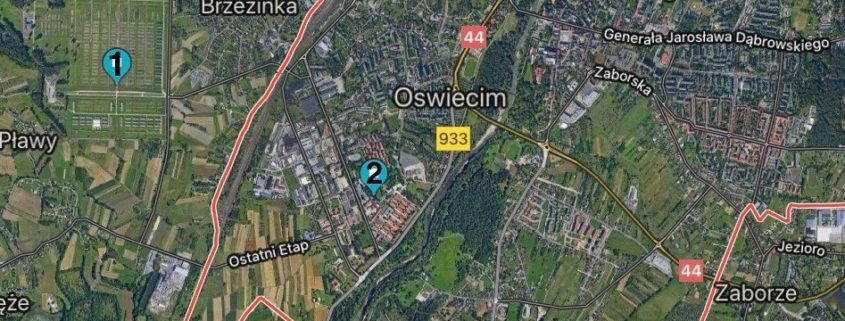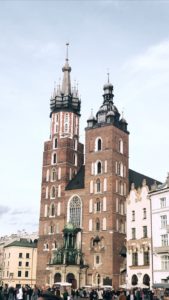The Jewish Auschwitz Center: Putting Oshpitsin Back on the Map
By Jacqueline Murrer
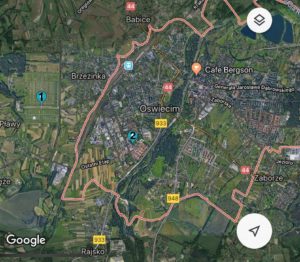
Map of the town of Oswiecim, with its borders in orange. The marker #1 shows where Auschwitz-Birkenau is located just outside of the town, and #2 is Auschwitz-I, which sits within the town borders
The town of Oshpitsin sits in the south of Poland, and was founded nearly 800 years ago. Today it is home to about 39,000 people, and has its fair share of cafés, and a revitalized city center. Though it has been around for hundreds of years, it’s history from the 720 years before World War II was largely forgotten, which is why it may come as a surprise that the Yiddish name, “Osphitsin” is interchangeable with the Polish name, “Oswiecim”, or better known as “Auschwitz”. Before World War II, this town was one of many in the region that were multi-cultural. For German speakers, the town was “Auschwitz”, for Polish speakers it was “Oswiecim”, and for Yiddish speaking Jews, the town was “Oshpitsin”.
Auschwitz is a name most commonly used in reference to the largest concentration camp of World War II. However, the German occupation derived this name after the pre-existing town that they took over to run the camps. They settled into the town of Oswiecim, which is a Polish town today. They then named the concentration camp after the town, but with a German version, “Auschwitz”. It is not well known that Auschwitz is not just the name of the Auschwitz-Birkenau camp. Today, Oswiecim is a Polish town, but after WWII the concentration and extermination camp named “Auschwitz” has become a symbol of the Holocaust. This World War Two history completely dominates the narrative of today’s town, with people living in its shadow. The history of the pre-war old Jewish town that existed there before WWII has experienced even more of a domination, with its history being almost completely erased by the creation of the camp and the decimation of the Jews. This is why you may have never heard of the town and its unique history.
In the years leading up to World War II, Oswiecim had about 7,000 Jewish occupants, which made up more than half of the population. Many people were then kicked out of their homes and forced to move to surrounding areas while Nazi Germany took over the land. Polish residents from part of the town and its surrounding areas were successfully evacuated as the camp grew and parts of the town were destroyed. On the other hand, Jewish life in the town came to an end in 1941, when the Jewish residents were deported to ghettos in Silesia.
Due to the loss of community, and the dark shadows cast upon the town by the death camp, it has been a mission of the town of Oswiecim to create a new identity for itself; one that sets them apart from the horrific history of the Second World War. To do this, the Polish government granted money to the town for renovation. This helped fund the creation and opening of a new library and a renovated city center to provide the people of the town with an open public space to enjoy. Trying to liven up a place better known around the world for its close proximity to a death camp, has been a challenge both logistically and morally. Businessman Fred Schwartz told the Jewish Telegraphic Agency, that “a major issue is how to preserve the sanctity of the camps along with the requirements of a significant population trying to live respectable lives and feeling that they are bearing the burden of a past that they did not take part in.” Controversy struck when a discotheque was opened in a building used by the Nazis during the Holocaust. Many people were livid that a place meant for partying and celebration was constructed in a building where the private belongings of Auschwitz victims were stored and sorted through. The owners of the disco argued that it was important to create a place where people “escape” from their sad, negative surroundings and have fun, in order to move on from such a dark history. Eventually, the disco was closed. There are today cafés, cinemas, and restaurants open in Oswiecim that serve to liven up the town, however, in trying to move on from the wretched history of Auschwitz, how much of the Jewish history of Oshpitsin is remembered or recognized?
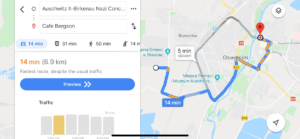
Café Bergson, and the Auschwitz Jewish center & museum are only a 14-minute drive away from the concentration camp
That is where the Auschwitz Jewish Center, and Café Bergson get involved. Opened in September of 2005, the Auschwitz Jewish Center sits just two miles from the concentration camp of Auschwitz-Birkenau. Today, the center is affiliated with the Museum of Jewish Heritage in New York City, USA, and it serves as the only Jewish presence in Oswiecim. The $10 million dollar center actually is made up of three parts: a synagogue, a museum, and a cafe. The Chevra Lomdei Mishnayot Synagogue, which is the only surviving Jewish synagogue in Oswiecim from before the Second World War. Before WWII, the town of Oswiecim alone had 30 synagogues, though the Chevra Lomdei Mishnayot was the only one still standing after the Holocaust. This single synagogue survived because it was taken over by Nazi Germans to house their ammunition and weaponry during the war. After the war was over, the communist government at the time converted the synagogue into a carpet warehouse, and it wasn’t until 1998 that the synagogue became the very first piece of Jewish property to be returned to its Jewish community in Poland. The synagogue was then donated to the Auschwitz Jewish Foundation, which brings us to today, when the synagogue is once again open to the public for prayer and visits.
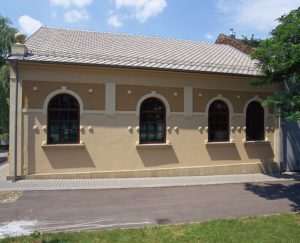
Outside of the Chevra Lomdei Mishnayot Synagogue, open-source photo provided by the Auschwitz Jewish Center
The next component of the Auschwitz Jewish Center is the Jewish Museum. The Jewish Museum sits in part of the former Kornreich family house. The Jewish Museum contains many artifacts and testimonials from the pre-war Jewish town of Oshpitsin in order to remember the victims of the Holocaust, but also to honor and teach about the culture and history of the Jewish community that lived in Osphitsin. Auschwitz and the Holocaust in general destroyed Oshpitsin and its vibrant Jewish life and community. In trying to navigate how to bring Oswiecim back to life as a fully-functional town, it is important to not only recognize the people that died in the Holocaust and at Auschwitz, but also the lives of the Jewish people whose homes and entire neighborhoods were demolished. The museum houses many photographs and documents from old Jewish-owned businesses and organizations. Photos show the bustling streets and beautiful buildings that made up the town, and allows visitors to imagine what life was like before World War II. In addition to the museum exhibitions, the Auschwitz Jewish Center has also designed and developed an application for smartphones, that allows people to learn more about the Jewish community and history of Oshpitsin on their own mobile device. This app is an incredible way for people to learn more about this pre-war Jewish history because it caters to younger audiences that are more drawn to technology, and it allows for people all over the world to access information from the museum if they are unable to see the exhibition in person.
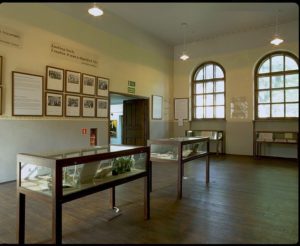
Inside of the Chevra Lomdei Mishnayot Synagogue, open-source photo provided by the Auschwitz Jewish Center
The last component of the Auschwitz Jewish Center in Oswiecim is Café Bergson. Café Bergson sits on the main floor of the Kluger family’s house, which belonged to the last Jewish family in Oswiecim. Szymon Kluger grew up in Oswiecim before the Second World War, when he was deported to a Jewish ghetto. Kluger was later taken to the Gross-Rosen and Buchenwald concentration camps. Luckily, Kluger survived the Holocaust and was liberated from the camps. After the war he settled in Sweden, but later returned to Oswiecim to live in his old family home, and became the only known Jewish person to return to Oswiecim after WWII. By using and preserving the Kluger family’s home in Oswiecim and spreading awareness about the story of Szymon Kluger, the café connects the towns pre-war past to the present and future.
The café preserves the old Jewish home while also adding small designs and décor to modernize the space, but to also blend the past and the future. For example, the café has modern paintings on the wall, but alongside them are photos of old tiles that were typical decorations in pre-war homes in Oswiecim. There also are posters on the walls, as well as t-shirts for sale, with the slogan “coexist” on them. This is from the Coexist Campaign based out of Washington, D.C. and London, U.K. which aims to advance social cohesion and cooperation (the symbol for the campaign in the word “coexist”, but made up of the Star of David as the “x”, and the cross as the “t”, etc.). Art like this which can be used in connection with the past, but also as a movement for the future is a great representation of what the café is all about. The art and openness of the space serves as a reflection of the café’s effort to create a space that brings different people together, and also refers to the coexistence of different groups in the past in the city.
The café connects to part of the museum, so visitors and customers alike can enjoy delicious coffee and pastries, and are also welcome to see the exhibitions. The café also brings together different people from around the world to work there – mostly on a volunteer basis, two of whom my class had the pleasure of meeting. One was from Germany with an organization called “Action Reconciliation”, and he is spending a gap year volunteering with them. The other was from Austria, and he was doing his volunteer work at the café as a part of civil service in lieu of military service. With this volunteer opportunity at Café Bergson, young people are encountering their own history in Oswiecim. Both Austria and Germany were perpetrating governments in WWII, so this has a lot to do with dealing with the past and contributing to a different, better future – a common them of the café’s work. Café Bergson is a beautiful example of the balance between maintenance and preservation of history, and moving on form dark pasts and creating something positive. The café lives within an old Jewish family home, which was very close to being torn down, and honors the lives of the Kluger family, as well as the history shown in the attached museum exhibit. Additionally, the café has made small renovations to make the space accessible to a broader population, and to make the space more cozy and inviting. This allows for both the memory of those lost in the Holocaust, but also the celebration of the life of Szymon Kluger.
With all three of its crucial parts, the Jewish Auschwitz Center serves as the only active Jewish establishment in the entire Oswiecim, or “Auschwitz” area. Sitting only two kilometers away from the Auschwitz-Birkenau concentration and death camp, it can be seen as a little glimpse of light in what feels like such a dark, sad community. The synagogue, museum, and the café all work together in order to educate visitors about the town that once thrived in the place of what is today called Auschwitz. What makes the Auschwitz Jewish Center stand out amongst other places is the fact that the center teaches not only about death and tragedy. The museum serves as a place to go to learn about the culture and everyday lives of the people of Oshpitsin hundreds of years ago. Unlike most places that give extensive information about the tragedies that took place during the second world war, Café Bergson is a refreshing place to learn about the culture and communities that existed before the war destroyed them.
Oshpitsin is being brought to light by the work being done by the Auschwitz Jewish Center and others to bring awareness to the life in the city prior to the establishment in the town by the Nazi’s of a mass killing center that became the symbol of the Holocaust. “Oshpitsin” was the name referred to the town by the Jewish residents and Jewish travelers, but in this case, the Jewish history of the town was wiped out by the Holocaust and is completely covered over too by the existence of the concentration camp, and now a museum to some of the greatest horrors of WWII. Making a place for this Jewish past in today’s city of Oswiecim, and a place through the Jewish museum and Café Bergson where this history and topics tied to today’s democratic and pluralistic concerns can be explored, is ingrained in the notion of putting Oshpitsin back on the map.

